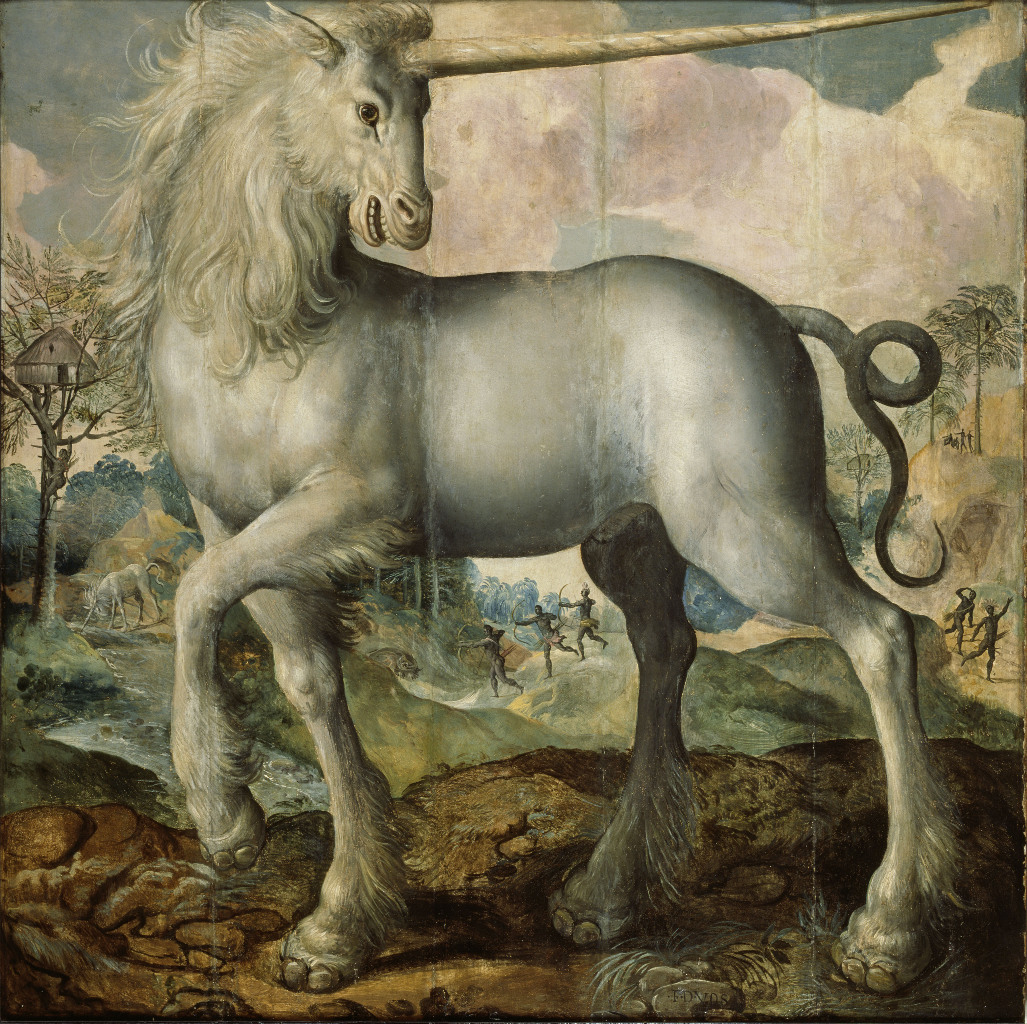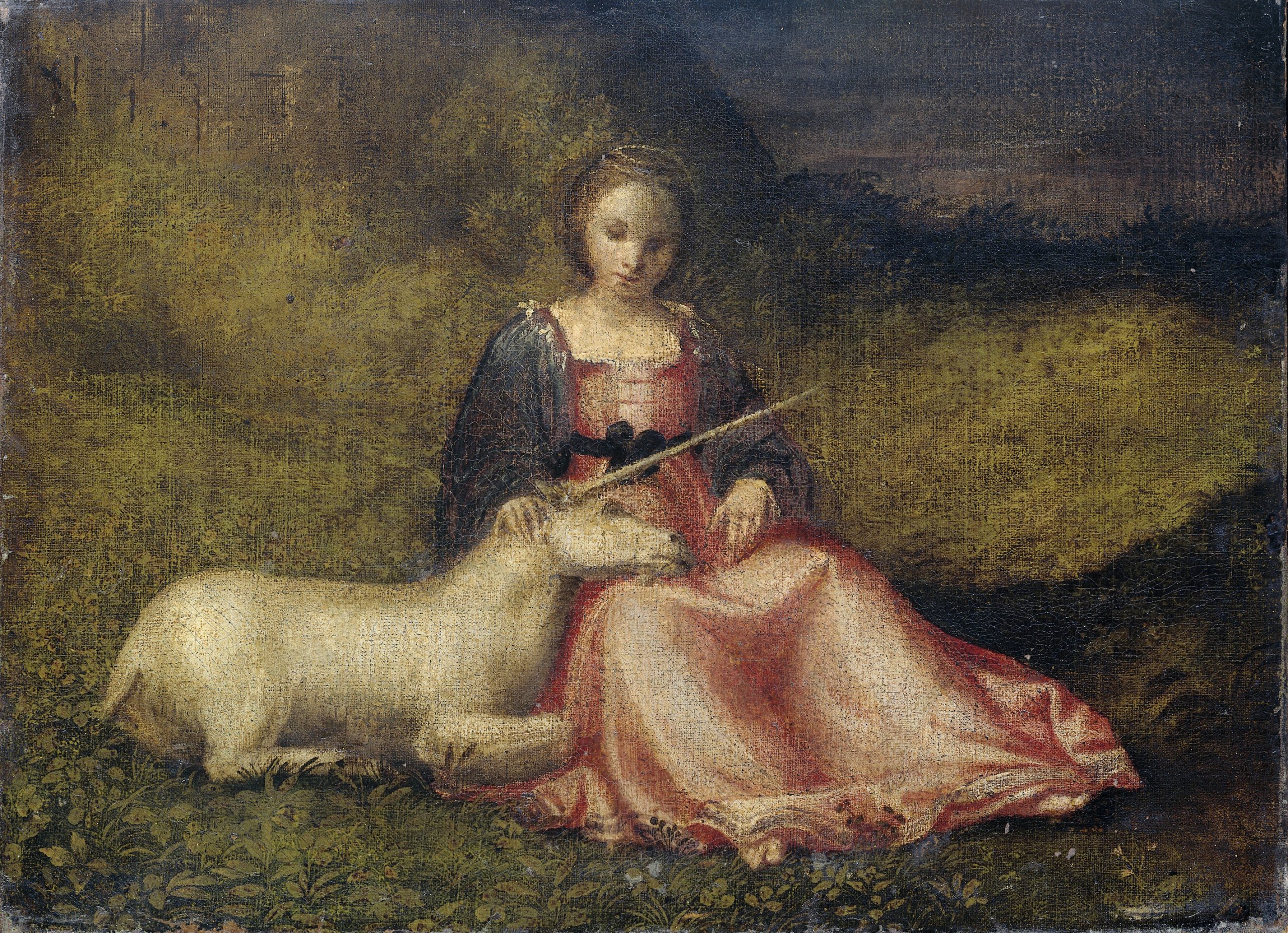21 The Unicorn in Art and Poetry
One of a Kind: The Monoceros (Unicorn) in Art and Poetry
“The unicorn is a creature of mystery and of faith, not a specimen to be caged or dissected. Indeed, when these pages have crumbled into dust, it is the mystery that will endure, and not the explanation” -Michael Green, 1983.

“https://commons.wikimedia.org/wiki/File:Maerten_de_Vos_-_Unicorn.jpg” by Staatliches Museum Schwerin is licensed under CC0 by 1.0.
The Unicorn
Depicted as a type of white horse with a single horn (monocerus), the legendary mythical unicorn is often seen as a symbol of purity, strength, grace, and beauty. Unicorns in legends and fairy tales are said to possess magical qualities. Unicorns continue to be popular in fantasy and contemporary adaptations of myths and folktales. Folklore from Medieval and Renaissance times, these magical and wild forest creatures unicorns could only be tamed and calmed by virgins. Imaginative paintings and etchings have held the imagination of artists for centuries. As Kendall, Norell, and Ellis write (2016) the mythic unicorns are often depicted as powerful and peaceful. Mysterious and solitary, when humans encounter unicorns, no harm is done. In contrast, the peaceful unicorn is often the target of a hunt.
From “In Praise of Unicorns” by James Huneker ( 1857-1921) CHARLES SCRIBNER’S SONS. 1917
https://www.gutenberg.org/files/39116/39116-h/39116-h.htm
“In the golden book of wit and wisdom, Through the Looking-Glass, the Unicorn rather disdainfully remarks that he had believed children to be fabulous monsters. Alice smilingly retorts: “Do you know, I always thought Unicorns were fabulous monsters, too? I never saw one alive before!” “Well, now that we have seen each other,” said the Unicorn, “if you’ll believe in me, I’ll believe in you. Is that a bargain?” “Yes, if you like,” said Alice. No such ambiguous bargains are needed to demonstrate the existence of Unicorns. That is, not for imaginative people. A mythical monster, a heraldic animal, he figures in the dictionary as the Monoceros, habitat, India; and he is the biblical Urus, sporting one horn, a goat beard and a lion’s tail. He may be all these things for practical persons; no man is a genius to his wife. But maugre that he is something more for dreamers of dreams; though not the Hippogriff, with its liberating wings, volplaning through the Fourth Dimension of Space; nor yet is he tender Undine, spirit of fountains, of whom the Unicorn asked: “By the waters of what valley has jealous mankind hidden the source of your secrets?” (Cousin german to the Centaur of Maurice de Guérin, he can speak in like cadence.)”

“The Unicorn” by Rainer Maria Rilke (1875-1926)
The saintly hermit, midway through his prayers
Stopped suddenly, and raised his eye to witness
The unbelievable; for there before him stood
The legendary creature, startling white, that
Had approached, soundlessly, pleading with his eyes.
The legs, so delicately shaped, balance a
Body wrought of finest ivory. And as
He moved, his coat shone like reflected moonlight.
High on his forehead, rose the magic horn, the sign
Of his uniqueness: a tower held upright
By his alert, yet gentle timid gait.
The mouth of softest tints of rose and grey, when
Opened slightly, revealed his gleaming teeth,
Whiter than snow. The nostril quivered faintly;
He sought to quench his thirst, to rest and find repose.
His eyes looked far beyond the saint’s enclosure,
Reflecting vistas and events long vanished. His eyes looked far beyond the saint’s enclosure,
reflecting vistas and events long vanished,
And closed the circle of this ancient mystic legend.
Retrieved March 26, 2023 https://www.poetry.com/poem/29740/the-unicorn
For more poems by Rainer Maria Rilke please open the link below:
https://ia800206.us.archive.org/23/items/cu31924026255822/cu31924026255822.pdf
Note about the Poet Rainer Maria Rilke (1876-1929)
Rainer Maria Rilke (1876-1929) was one of the most lyrical and creative poets and writers. Rilke’s writing reflects careful attention to the meaning of physical objects that while silent, hold layers of symbolic meaning. He was fascinated by Russian mysticism and began to explore spiritual and mythical themes and their relation to the human psyche and existence, In 1899, Rilke and his wife Lou Andras-Salome visited Russia. Fascinated by Russian mysticism, Rilke began writing The Book of Hours: The Monastic Life in 1905. Rilke’s (1929) book Letters to a young poet has been an important source of wisdom, inspiration, and insight for many individuals who with existential questions about life’s meaning, suffering, loneliness, creativity. resilience, and self-reliance. Rilke’s writing reflects the mysteries of life and the challenge of finding love and connection in difficult times. Rather than fearing loneliness, Rilke emphasizes the importance of solitude as a time of contemplation, close observation, and the development of life wisdom. “IN an urban, industrial world seeming to lack satisfactory religious answers to the ultimate questions, all these figures (e.g. poets like Rainer Maria Rilke, Ralph Waldo Emerson, and Henry David Thoreau) felt the need to look within themselves for forces and truths that could connect them to other people” (Searls, 2021, p. xi).
In his letters to a young would-be poet (1903-1908), Rilke offered words of advice to the aspiring poet Franz Xaver Kappus:
You are looking outward, and that, more than anything, is what you should not be doing. No one can help you or give you advice, no one. The only thing to do is: Go into yourself. Look for the reson that is making you write; see whether it has put down roots n the deepest place in your heart… (Searls (Ed.) , 2021, pp. 4-5).
Rilke encourages Franz X. Kappus (the “young poet”) to tap into life experiences and inner thoughts and feelings. Daily experiences, nature, people, and non-human life can become sources of contemplation and insight. The “treasure-house” of memories includes childhood experiences. He explains:
Avoid general themes and write about what your everyday life has to offer; describe your sorrows and longings, your passing thoughts, your belief in this or that beauty, and describe it with heartfelt, silent, humble sincerity and candour. In expressing yourself, use the things around you, images from your dreams, objects of your memory.
In The Book of Hours, Rilke (1903) writes:
Art, like Nature, the great and only reservoir for all time past and all time to come, ever strives for elimination and selection. It is severe and aristocratic in the application of its laws and impervious to appeal to serve other than its own aims. Its purpose is the symbolization of Life. In its sanctum there reigns the silence of vast accomplishment, the serene, final, and imperturbable solitude which is the ultimate criterion of all great things created. Retrieved March 26, 2023. The Book of Hours by Rainer Maria Rilke.
https://www.gutenberg.org/files/38594/38594-h/38594-h.htm
“To speak of Poetry is to speak of the most subtle, the most delicate, and the most accurate instrument with which to measure life.” -Retrieved, March 26, 2023 https://www.azquotes.com/author/12367-Rainer_Maria_Rilke
“Poetry is reality’s essence visioned and made manifest by one endowed with a perception acutely sensitive to sound, form, and colour, and gifted with a power to shape into rhythmic and rhymed verbal symbols the reaction to Life’s phenomena. The poet moulds that which appears evanescent and ephemeral in image and in mood into everlasting values. In this act of creation he serves eternity.”- Rainer Maria Rilke. https://www.azquotes.com/author/12367-Rainer_Maria_Rilke
From: Searls,D. (translator, 2021) Letters to a young poet (with the letters from the ‘young poet’-Franz Xaver Kappus) by Rainer Maria Rilke. Liveright Publishing.
Additional Resources
https://allpoetry.com/Rainer-Maria-Rilke
https://en.wikipedia.org/wiki/The_Book_of_Hours

